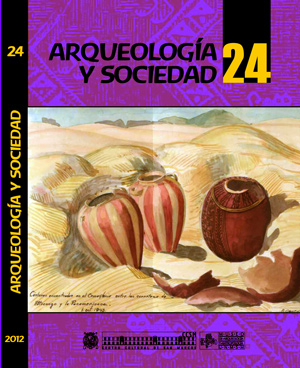ARTE RUPESTRE AFRICANO EN LAS CUEVAS DE CUBA. LA NECESIDAD DE UN CAMBIO EN LAS HERRAMIENTAS METODOLÓGICAS
DOI:
https://doi.org/10.15381/arqueolsoc.2012n24.e12335Palabras clave:
Arte rupestre, petroglifos, africanos, esclavos, cimarrones, metodología.Resumen
Se presenta un análisis crítico de algunos de los presupuestos filosóficos, proyecciones teóricas, métodos y propuestas que se han utilizado como herramientas para intentar demostrar la posible ejecución de diseños rupestres cubanos por parte de individuos o grupos de africanos que, huidos de haciendas, ingenios, casas señoriales y convertidos en cimarrones, se refugiaban en los bosques y serranías del país, entre los siglos XVI y XIX. Este análisis demuestra que, hasta hoy, la mayoría de tales enfoques no han obtenido el resultado esperado, al estar concentrados en comparaciones morfológicas e inducciones mitologizadas de escasos alcances. La voluntad de obtener respuestas más certeras y efectivas ante esta problemática impone un rediseño de los presupuestos y métodos utilizados, así como un cambio en la forma de asumir el abordaje de las estaciones rupestres de posible factura africana.Descargas
Publicado
Número
Sección
Licencia
Derechos de autor 2012 Divaldo Gutiérrez Calvache, José González Tendero, Racso Fernández Ortega

Esta obra está bajo una licencia internacional Creative Commons Atribución-NoComercial-CompartirIgual 4.0.
LOS AUTORES RETIENEN SUS DERECHOS:
a. Los autores retienen sus derechos de marca y patente, y también sobre cualquier proceso o procedimiento descrito en el artículo.
b. Los autores retienen el derecho de compartir, copiar, distribuir, ejecutar y comunicar públicamente el artículo publicado en la Revista Arqueología y Sociedad (por ejemplo, colocarlo en un repositorio institucional o publicarlo en un libro), con un reconocimiento de su publicación inicial en la Revista Arqueología y Sociedad.
c. Los autores retienen el derecho a hacer una posterior publicación de su trabajo, de utilizar el artículo o cualquier parte de aquel (por ejemplo: una compilación de sus trabajos, notas para conferencias, tesis, o para un libro), siempre que indiquen la fuente de publicación (autores del trabajo, revista, volumen, número y fecha).






